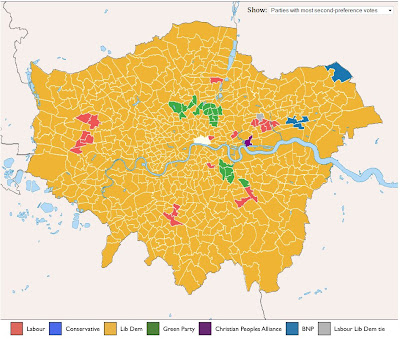What are we voting for?
Tomorrow is election day in London, but what are we voting for and how do we vote? I’ve had a few queries about this, especially from people new to London for whom this is their first City Hall election, so here’s a handy guide. If you want to know more about the candidates or their policies, then read my guide to the Mayoral election, and the Barnet & Camden Assembly Member election.
Here’s how it works
Mayor of London
This is the pink ballot paper.
The Mayor of London is elected by supplementary vote. This means you can vote for two candidates in order of preference:
- Vote for your first choice candidate by marking a cross (X) in the first choice column
- Vote for your second choice candidate by marking a cross (X) in the second choice column
- You must mark a first choice, you can choose not to mark a second candidate
- If you mark only a second choice your vote will not be counted
- If you give the same candidate your first and second choice, only your first choice will be counted
If a candidate receives more than 50% of all the first choice votes they are elected immediately. If this does not happen (which it won’t), the top two candidates with the most first choice votes go through to a second round. All the ballot papers where another candidate was first choice are then reassessed to tally up second preferences. Second choice votes for either of the top two candidates are added to the totals for those two candidates from the first round. The candidate with the highest combined total of first and second choice votes will be elected as Mayor of London.
What does this mean in practice? Most pundits call this as a two-horse race between Ken & Boris, so if you want to vote tactically, consider that if you vote for either of those two as first preference then your second vote is unlikely to matter. If you want to vote for another candidate first, then voting for either Ken or Boris second probably makes sense. The Green Party, for example, would prefer you to vote Green first, and Labour second. Or, vote for who you’d actually like to see as Mayor – surprises do occur, and this sort of voting sends a clear message to City Hall as to what people’s concerns are.
In 2008, every single ward in London voted either Boris or Ken first, but almost all of them voted Brian Paddick as second preference. As he wasn’t in the top two however, this counted for nothing. The maps below, along with other cuts of the voting data, are from The Guardian.
 |
| A fairly clear inner/outer London divide |
 |
| “And it was all yellow”: 2nd preference votes in 2008 |
London Assembly – Constituency members
The London Assembly consists of 14 constituency members who represent different areas of London, and 11 London-wide members. In West Hampstead, we are in the Barnet & Camden constituency, those of you the other side of Kilburn High Road are in Brent & Harrow.
This is the yellow ballot paper
The constituency election is first past the post. Simply put a cross against the name of the candidate you’d like to represent you in the London Assembly.
London Assembly – London-wide members
This is the orange ballot paper
The 11 London-wide Assembly Members are elected using a form of proportional representation.
- You can cast one vote for the party or independent candidate that you would like to have a London-wide Member seat on the Assembly.
You can see the full list of parties here. You don’t vote for a specific candidate within each party. Each party will have its own internal list – lets say that Labour wins three London-wide seats, then the top three names on Labour’s list will be elected. You can see on the list I’ve linked to that the first names under the main parties are established London politicians like Nicky Gavron and Caroline Pidgeon.
Votes from across London for the London-wide Assembly Members are added together. The 11 seats are then allocated based upon a mathematical formula (the Modified d’Hondt Formula since you asked). This takes into account the total votes cast in the London-wide ballot together with the number of Constituency London Assembly Member seats that each political party has already won. It is a bit complicated to explain, but basically 11 rounds of calculations take place to fill the 11 London-wide Assembly Member seats, and the party or independent candidate with the highest result at each round is allocated the seat. Seats won by parties are allocated to party candidates in the order they appear on the relevant party’s list of candidates.
What does this mean in practice? It’s pretty straightforward really – vote for the party you’d like to see have as many seats as possible in the Assembly. You might, for example, want to see Boris as mayor but think that having more Green Assembly Members would be a good balance. Or perhaps you think Brian Paddick’s crime policies make him the ideal mayor, but a strong Labour presence in the Assembly might help address some of the other social problems facing the city.
There’s loads more information on all this at the London Elects site.
Polling stations in Camden are open from 7am to 10pm. if you can’t find your polling card, you can find your polling station by postcode. Note that your polling station may not be the one physically nearest to you, as they’re broken down by ward and sub-ward.




Really useful – thanks!